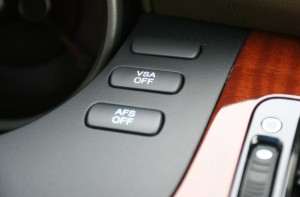
Many cars allow you to turn off ESC and its suite of electronics for certain driving situations, e.g. getting out of snow or mud where it might be desirable to have wheelspin
Electronic Stability Control is a set of electronics that works to determine if a car is skidding. If it detects loss of control it selectively applies the brakes on each wheel to bring the vehicle back into a straight line. Having tested a car with ESC on a skid pan, I can verify that it is nigh on impossible to spin. As soon as you get the slightest bit of sideways action the vehicle intervenes and aligns itself to wherever you are pointing the steering wheel.
Because ESC is so good (it’s said to reduce accident rates due to loss of control by around 30%) the New Zealand government has mandated that all new imports into the country as of July 1, 2015 must be fitted with ESC. Used class MC vehicles (all-wheel drive SUVs and off-road vehicles) must comply by January 1, 2016, used class MA (passenger cars with engines greater than 2 litres by January 1, 2018 and all other used light passenger and goods vehicles by January 1, 2020.
We already have some of the strictest regulations about what can be imported and our cars (especially luxury ones) are an order of magnitude more expensive than places like New Zealand. Recently, concern has arisen regarding a recommendation that some of these restrictions should be lifted.
Australia has mandated ESC on all new cars since January 2011, allowing manufacturers to run out their model lines through to November 2013. Now all new cars must have it. The current restriction only applies to passenger vehicles; light commercial vehicles are exempt until November 1, 2015.
ESC is the generic acronym, but the feature itself is called different things by different manufacturers, for example:
- ESP – Electronic Stability Program (Audi, Bentley, Bugatti, Chery, Chrysler, Citroen, Dodge, Daimler, Fiat, Ford, Holden, Hyundai, Jeep, Kia, Lamborghini, Mercedes-Benz, Peugeot, Renault, Skoda, Suzuki and Volkswagen)
- VDC – Vehicle Dynamic Control (Alfa Romeo, Nissan, and Subaru)
- VSA – Vehicle Stability Assist (Honda and Hyundai)
- DSC – Dynamic Stability Control (Ford, Jaguar, Mazda and Mini)
- PSM – Porsche Stability Management (Porsche)
There are others, too. The majority of cars new cars worldwide already come with a version of ESC. In fact, all cars built in Europe have had to have ESC installed since November 1, 2011. Most Japanese and Korean cars already do. It’s really only the base models, some Chinese brands like Chery and some utes that lack ESC. By 2020, the lower-mid-range car bought now will be six years old and worth pretty much nothing – it’ll be the perfect first car for a new driver and chances are it will have ESC, and if not, it’ll have anti-lock brakes, and probably electronic brakeforce distribution.
The legislation will possibly increase competition for secondhand cars that are priced where the base model cars are priced because people that perhaps would purchase a base model car will now be forced to look for a slightly older model that has ESC.
However, concerns about pricing were mooted when New Zealand changed its laws several years ago so that vehicles over a certain age couldn’t be imported. This was to encourage better frontal impact standards and exhaust emissions.
Vehicles over 25 years old are considered classic vehicles and will be able to be imported, as will specialist vehicles under New Zealand’s Low Volume Vehicle Technical Association.
